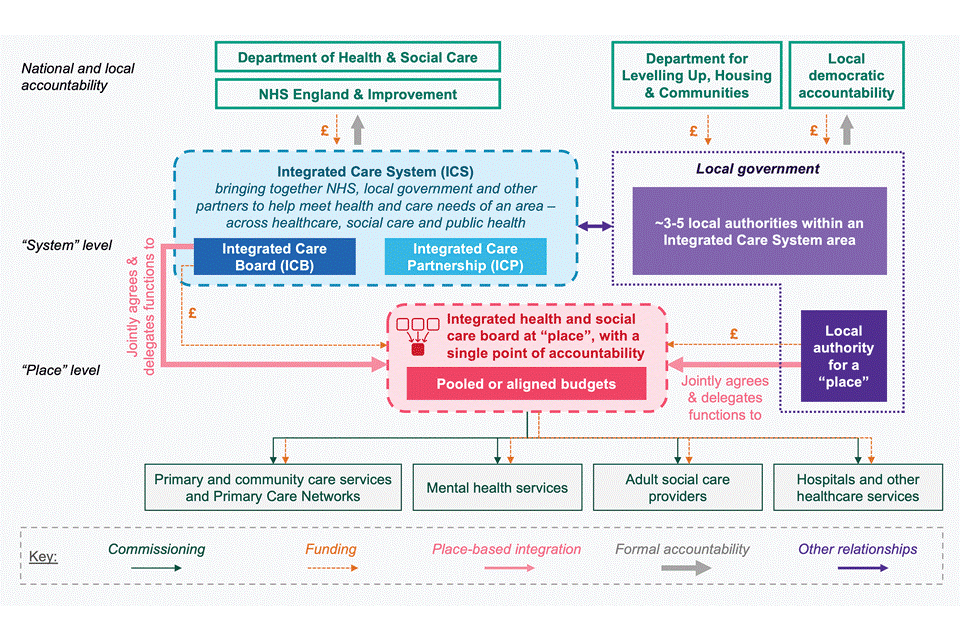The paper explains that “while strategic, at-scale planning is carried out at the Integrated Care Systems level, places will be the engine for delivery and reform”. While places have no statutory status, they are a key player in the new system and are expected to operate below ICS system level.
In this article, we consider the ICS proposals outlined in the White Paper.
All places within an ICS should adopt a governance model by Spring 2023, with clear accountability arrangements
The paper is clear that places are free to adopt the governance model outlined in the paper or an equivalent model, if it achieves the same aims. For example, the expectation is that the governance model provides clarity of decision-making covering:
- Reshaping services within the place (and on wider decisions such as reconfigurations across a wider geography)
- Practical solutions to managing risk and disputes between local partners and for managing the outcomes to be pursued locally in addition to those set nationally (reference is made to ensuring ‘strong involvement’ from the health and care provider organisations for that place)
- The need for a single accountable person at place-level accountable for the delivery of shared outcomes and plans across health and social care. The paper explains that the individual may be an individual with dual role across health and care or an individual lead for a ‘place board’. It says that “The single person will be agreed by the relevant local authority or authorities and ICB.” and notes that the proposal will not change the current local democratic accountability or formal Accountable Officer duties within local authorities, those of the ICB Chief Executive or relevant national bodies, such as the ability of NHS England to exercise its functions and duties.
So while places will be able to decide which accountability model they adopt – the illustrative model outlined in the paper (the place board model) builds on the Thriving Places guidance jointly produced by LGA and NHS England in September 2021.
The place board model arrangement is described at page 34 but in short, a 'place board' brings together partner organisations to pool resources, make decisions and plan jointly – with a single person accountable for the delivery of shared outcomes and plans, working with local partners. The expectation is that in this system the council and ICB would delegate their functions and budgets to the board with integration of decision-making achieved through formal governance arrangements. The paper explains that the place board lead would be agreed by the ICB and the local authority (or authorities) for the place.
No changes to ICS boundaries
On ICS boundaries, there are no plans for further changes which will be reassuring for systems worried about unpicking existing plans. The expectation is for “…place-based arrangements to align with existing ICS boundaries as far as possible. The paper explains that “We recognise that in some geographies this can be challenging, and we expect NHS and local authority partners to work together (drawing, where needed, on the flexibilities that the legislation will provide, subject to Parliament) to ensure that all citizens are able to benefit from effective arrangements wherever they live.”
ICSs to develop shared outcomes frameworks by Spring 2023
In addition to the clarity on governance arrangements, all places will need to develop a shared outcomes framework by Spring 2023. The intent is for the outcomes to sit alongside systems’ and organisations’ statutory duties and regulatory frameworks to address the problem of organisations being pulled in different directions by competing outcomes and targets.
ICS funding flows
The diagram at page 35 suggests that all funding will flow from the ICB to the Integrated health and social care board at ‘place’ where the pooled and aligned budgets will be held. However, the note of the diagram does say that it is a “simplified example of potential governance arrangements and not a full representation of the richness, complexity and range of partnership working across the organisations within the systems.”

Our content explained
Every piece of content we create is correct on the date it’s published but please don’t rely on it as legal advice. If you’d like to speak to us about your own legal requirements, please contact one of our expert lawyers.